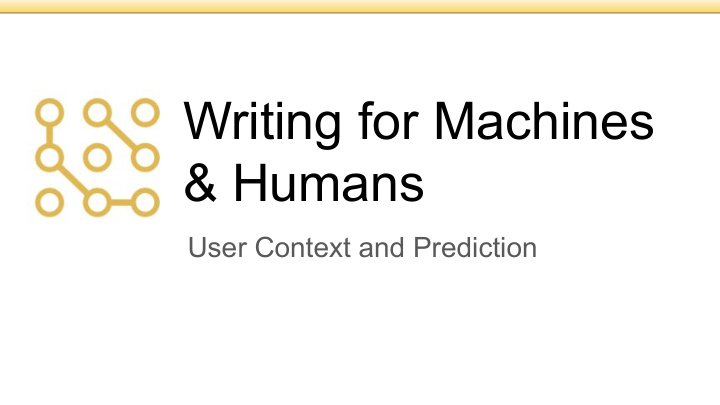



Writing for Machines & Humans User Context and Prediction
Information in cohabitation with IoT, Chatbots, and AI ● molecular ● dynamic ● ubiquitous ● spontaneous ● offered ● profiled information4zero.org
Overview ○ Define user context ○ Examples of user context ○ How to derive user context ○ Current research into prediction methods ○ How prediction may be used to drive future technologies
What’s your context?
What is user context?
Any information that is relevant in defining the situation of a user (or device)
Context is not static. It’s an observation of a particular time space.
Context in AI-related technology ● Context is a matrix of detectable properties. ● It is volatile and adaptive. ● Often triggered (sensors, devices, location…). ● It probably has consequences that can be predictable.
The goal of user context... ...is to detect users’ needs and possibly make the content personal.
Why is user context important? ● Allows us to deliver information that is relevant to a specific user at a specific time and place ● Improves the quality of the interaction ● Provides a rich user experience
Elements of user context ● dynamic - total context is in a constant state of change, although there may be fixed states (i.e. birthdate, gender) ● matrix - incorporates multi-states ■ Identity ■ Time ■ Location ■ Activity
Context Classification
Context Classification ● Device state Computer screen Smart phone Smart watch Home alarm monitor 6 user context classifications* ● User state *Stephan Sigg, TU Braunschweig Institute of Operating Systems and Computer Networks www.ibr.cs.tu-bs.de
Identity ● Profile ● Role ● Access rights ● Level of expertise ● Social status ● Organizational status
Time
Location
Activity ● Moving ● Programming ● Documenting
Constitution Biological Mood ● Heart rate ● Angry ● Blood sugar ● Frustrated ● Zen
Environment Physical Technological ● Lighting ● Network ● Temperature ● Wifi ● Noise level ● Acceleration Equipment ● Glasses ● Smart watch ● Smart phone ● Keyboard
How can we know a user’s context?
Deriving context states (user and device) ● Authentication data ● User profile ● Sensors ● Social analysis
Deriving user context via authentication name gender job title user role user experience city & country of residence company
Deriving user context via authentication name city & country of residence user role Hi toni. Would you like to start writing? Hi toni. Welcome back Hi toni. Would you like to manage a project? Hi toni. How’s the weather in [city]?
Deriving user context via sensors device preference geolocation ambient light temperature motion headphone use time nearby places
Sensors Industry Sensors provide context of machines and automation.
Sensors ‘Us’ Sensors provide context of people.
‘Dig deep into your shoppers' behavior. Analyze foot traffic patterns, visualize conversion rate, calculate frequency of returning visitors, and build a complete shopper profile.’ countbox.us
Deriving user context via social media content hashtags sentiments preferences bias
Social Sensing ‘During events raising social alarm, such as earthquakes, contents shared by users of social media, if properly analyzed, allow you to have a real-time picture of the evolving situtation, the areas involved and the consequences. Users act as social sensors and their contents are valuable sources of information for emergency managers.’ socialsensing.it
Group Context When it’s not possible to derive individual context, use group context.
Context prediction
The Future of Context Sensors and algorithms
What is context prediction? The prediction of future context based on historical context states and extrapolation of future context states. Current research models: infer present context and predict future context
How can we predict user context? 1. Build a history of user context states 2. Classify context states 3. Learn behaviors based on context states 4. Use algorithms to extrapolate likely future states Ex: predicting location based on past behavior
User Context Prediction Model Individual High level Low level
Recap ● Context is any information that is relevant ● Classification of context states: in defining the situation of a user (or ○ Identity ○ Time device). ○ Location ○ Activity ● A context state an observation of a ○ Constitution particular time space. ○ Environment ● Context states are dynamic. ● Context can be sensed and inferred. ● Context allows us to deliver information ● In the future we’ll use models that predict that is relevant to a specific user at a user behavior and provide context. specific time and place.
Follow me on Linkedin: www.linkedin.com/in/toniressaire/ email: toni.ressaire@info4design.com training: Writing for Machines & Humans A new information delivery model for modern contexts. 18-hour online course Who writes content for voice interfaces such as Alexa and Google Assistant? It could be you. firehead.net/training
Recommend
More recommend